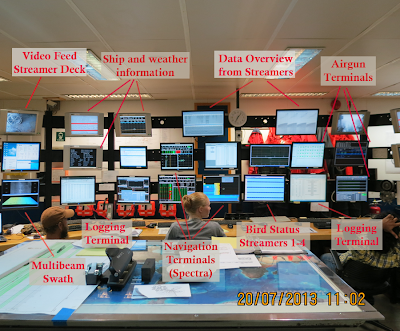 |
| A panorama view of the main science lab |
We left off last time with a tour of our sleeping quarters
thus it seems only appropriate to now walk through the room where we spend most
of waking hours; the main science lab.
Located one level below the gun deck, the main lab operates 24 hours a
day controlling every aspect of data acquisition from monitoring the
multichannel streamers and air-gun arrays to building the computers needed to
process the terabytes of data that barrel in.
 |
| An up close view of the numerous computer screens in the main lab |
It can safely be said that when acquiring 3D seismic data during
which approximately 6.5 terabytes of raw data will be recorded over 43 days you can
never have enough computers. In the main
lab, laptops and computers occupy every surface. Stand-alone computer monitors duck taped onto
desks sit next to laptops anchored by bungee cables. Power cords, Ethernet cables, and USB
connections snake across tables in every direction periodically diving down
into a dark power outlet. A bank of computer screens approximately 12 monitors
wide and 3 monitors tall encircles nearly half of the lab. These screens (39 in total) act as terminals
that allow us to monitor and control a myriad of processes that are summarized
in the image below. Possibly of greatest
importance are the terminals dedicated to “driving the ship.” We aim to always have the four streamers
following in perfect straight lines behind the ship however, cross-currents
make this is a difficult charge. Given
the length of 6 km (3.7 miles!) and the weight of the streamers, it is akin to a
toy boat towing four 23 m (75 ft) fishing lines straight behind it on a windy
day. Thus to keep the streamers in the optimum orientation with respect to our
acquisition line we continuously nudge the ship north and south while pulling
the heads of the streamers with us. All of the steering is done from a
combination of three monitors with the use of the software package “Spectra,” which
in the simplest sense determines real time data coverage given the location of
the air guns and the streamers.
 |
| A labeled view of the bank of computer monitors that dominates the lab |
Of equal importance are monitors that display the health of
the four streamers and the two air-gun arrays.
We aim to keep the streamers at a constant depth relative to the air-gun
arrays and also at a depth that keeps them protected from passing ship
traffic. In this part of the Atlantic
fishing vessels are common and with our gear sitting kilometers behind our ship
and 12 m (40 ft) beneath the sea surface one could see how a vessel might not
know that it is there. Therefore,
whenever we see an approaching boat we implore them to keep a safe distance
away both for the safety of their vessel and for our gear.
 |
| The back of the lab where most of the preprocessing and quality control is done. |
Additionally, we use this bank of terminals to monitor for
the presence of critters in the water, the weather and sea conditions, and the
health of the EM122 multi-beam. Sitting
back from the semi-circle of computers is another set of desks where the we, the students and scientists, stake our
claim. Outfitted with no-slip fabric and
duck tape, we have covered the back of the room with our computers, which we
use for pre-processing and quality control (QC) of the incoming data.
That about covers the main lab, they keep it pretty cold
down here for the sake of the computers so I’m headed up to grab another
sweatshirt before I get frost bite. Stay
warm out there!
Natalie Accardo
Lamont-Doherty
